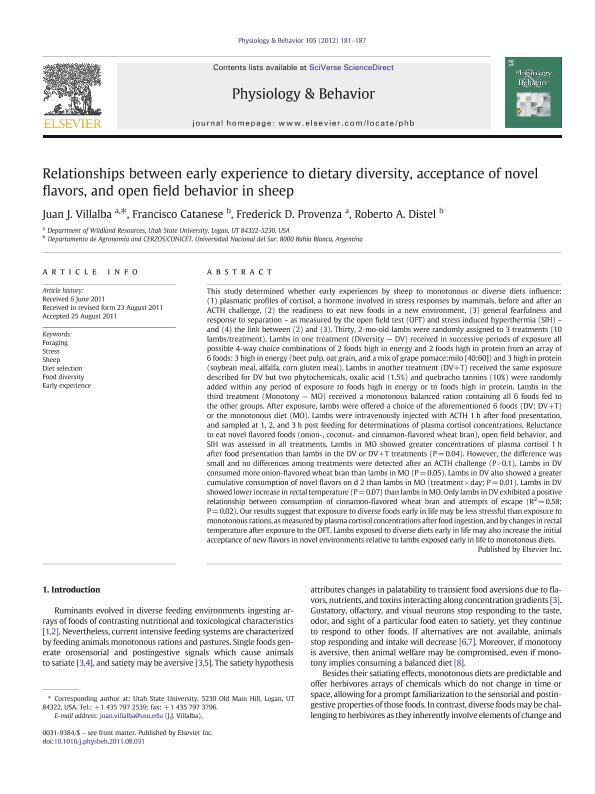Mostrar el registro sencillo del ítem
dc.contributor.author
Villalba, Juan J.
dc.contributor.author
Catanese, Francisco Hernan

dc.contributor.author
Provenza, Frederick D.
dc.contributor.author
Distel, Roberto Alejandro

dc.date.available
2017-07-07T19:13:30Z
dc.date.issued
2012-01
dc.identifier.citation
Villalba, Juan J.; Catanese, Francisco Hernan; Provenza, Frederick D.; Distel, Roberto Alejandro; Relationships between early experience to dietary diversity, acceptance of novel flavors, and open field behavior in sheep; Elsevier; Physiology And Behavior; 105; 2; 1-2012; 181-187
dc.identifier.issn
0031-9384
dc.identifier.uri
http://hdl.handle.net/11336/19866
dc.description.abstract
This study determined whether early experiences by sheep to monotonous or diverse diets influence: (1) plasmatic profiles of cortisol, a hormone involved in stress responses by mammals, before and after an ACTH challenge, (2) the readiness to eat new foods in a new environment, (3) general fearfulness and response to separation - as measured by the open field test (OFT) and stress induced hyperthermia (SIH) - and (4) the link between (2) and (3). Thirty, 2-mo-old lambs were randomly assigned to 3 treatments (10 lambs/treatment). Lambs in one treatment (Diversity - DV) received in successive periods of exposure all possible 4-way choice combinations of 2 foods high in energy and 2 foods high in protein from an array of 6 foods: 3 high in energy (beet pulp, oat grain, and a mix of grape pomace:milo [40:60]) and 3 high in protein (soybean meal, alfalfa, corn gluten meal). Lambs in another treatment (DV+T) received the same exposure described for DV but two phytochemicals, oxalic acid (1.5%) and quebracho tannins (10%) were randomly added within any period of exposure to foods high in energy or to foods high in protein. Lambs in the third treatment (Monotony - MO) received a monotonous balanced ration containing all 6 foods fed to the other groups. After exposure, lambs were offered a choice of the aforementioned 6 foods (DV; DV+T) or the monotonous diet (MO). Lambs were intravenously injected with ACTH 1h after food presentation, and sampled at 1, 2, and 3h post feeding for determinations of plasma cortisol concentrations. Reluctance to eat novel flavored foods (onion-, coconut- and cinnamon-flavored wheat bran), open field behavior, and SIH was assessed in all treatments. Lambs in MO showed greater concentrations of plasma cortisol 1h after food presentation than lambs in the DV or DV+T treatments (P=0.04). However, the difference was small and no differences among treatments were detected after an ACTH challenge (P>0.1). Lambs in DV consumed more onion-flavored wheat bran than lambs in MO (P=0.05). Lambs in DV also showed a greater cumulative consumption of novel flavors on d 2 than lambs in MO (treatment×day; P=0.01). Lambs in DV showed lower increase in rectal temperature (P=0.07) than lambs in MO. Only lambs in DV exhibited a positive relationship between consumption of cinnamon-flavored wheat bran and attempts of escape (R 2=0.58; P=0.02). Our results suggest that exposure to diverse foods early in life may be less stressful than exposure to monotonous rations, as measured by plasma cortisol concentrations after food ingestion, and by changes in rectal temperature after exposure to the OFT. Lambs exposed to diverse diets early in life may also increase the initial acceptance of new flavors in novel environments relative to lambs exposed early in life to monotonous diets.
dc.format
application/pdf
dc.language.iso
eng
dc.publisher
Elsevier

dc.rights
info:eu-repo/semantics/openAccess
dc.rights.uri
https://creativecommons.org/licenses/by-nc-nd/2.5/ar/
dc.subject
Diet Selection
dc.subject
Early Experience
dc.subject
Food Diversity
dc.subject
Foraging
dc.subject
Sheep
dc.subject
Stress
dc.subject.classification
Ganadería

dc.subject.classification
Producción Animal y Lechería

dc.subject.classification
CIENCIAS AGRÍCOLAS

dc.title
Relationships between early experience to dietary diversity, acceptance of novel flavors, and open field behavior in sheep
dc.type
info:eu-repo/semantics/article
dc.type
info:ar-repo/semantics/artículo
dc.type
info:eu-repo/semantics/publishedVersion
dc.date.updated
2017-07-03T14:51:31Z
dc.journal.volume
105
dc.journal.number
2
dc.journal.pagination
181-187
dc.journal.pais
Países Bajos

dc.journal.ciudad
Amsterdam
dc.description.fil
Fil: Villalba, Juan J.. State University Of Utah; Estados Unidos
dc.description.fil
Fil: Catanese, Francisco Hernan. Consejo Nacional de Investigaciones Científicas y Técnicas. Centro Científico Tecnológico Conicet - Bahía Blanca. Centro de Recursos Naturales Renovables de la Zona Semiarida. Universidad Nacional del Sur. Centro de Recursos Naturales Renovables de la Zona Semiarida; Argentina
dc.description.fil
Fil: Provenza, Frederick D.. State University Of Utah; Estados Unidos
dc.description.fil
Fil: Distel, Roberto Alejandro. Consejo Nacional de Investigaciones Científicas y Técnicas. Centro Científico Tecnológico Conicet - Bahía Blanca. Centro de Recursos Naturales Renovables de la Zona Semiarida. Universidad Nacional del Sur. Centro de Recursos Naturales Renovables de la Zona Semiarida; Argentina
dc.journal.title
Physiology And Behavior

dc.relation.alternativeid
info:eu-repo/semantics/altIdentifier/doi/http://dx.doi.org/10.1016/j.physbeh.2011.08.031
dc.relation.alternativeid
info:eu-repo/semantics/altIdentifier/url/http://www.sciencedirect.com/science/article/pii/S0031938411004264
Archivos asociados
